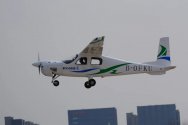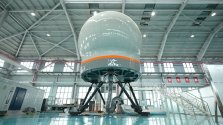You are using an out of date browser. It may not display this or other websites correctly.
You should upgrade or use an alternative browser.
You should upgrade or use an alternative browser.
Chinese Aviation Industry
- Thread starter FriedRiceNSpice
- Start date
Answer in the aeroengine thread, posted by zyzchysx (on page 750). Big upgrade in the ability to test engines within China.Is this true, I have never seen this white painted Y-20? The article couldn't confirm the validity of the news. But is based off of a video.
by78
General
This is pretty neat.
Northwestern Polytechnical University has developed a nano-surface structure that can achieve a drag reduction of over 50% compared to the best known international efforts. The structure is inspired by the ridges and dunes of the Kumtag desert.


According to reports, drag reduction is the focus of long-term attention in the aerospace field, which not only affects the pneumatic shape design and layout optimization of aircraft, but also has important application value for aircraft energy conservation, emission reduction and operation cost reduction.
In recent years, unlike the traditional means of reducing drag by changing the pneumatic layout of aircraft, experts in relevant fields at home and abroad have carried out in-depth research on changing the microstructure of aircraft surfaces to achieve drag reduction. For example, Lufthansa Aviation Technology has developed an aircraft "film" through the , which has been tested and applied to the Boeing 747-400 aircraft, which can effectively reduce the flight friction resistance.

Lufthansa's Sharkskin film.
However, the bionic "shark skin" structure still has problems such as low pneumatic drag reduction rate and poor wind direction robustness in practical application, that is, it is difficult to maintain the original pneumatic drag reduction performance when the wind direction changes. For this reason, Professor Yuan Weizheng, director of the Key Laboratory of the Ministry of Education of the Sky Micro-nano System, and Professor He Yang's team, with the support of key projects of the National Natural Science Foundation of China, after long-term comparison and analysis, extracted the characteristics of conditions based on similar criteria, and finally found a solution in the Kumtag desert.

The shape characteristics of the sand ridge in the Kumtag Desert. Photo provided by Northwest University of Technology
Talking about why the desert was chosen as a bionic object, He Yang said that sand grains naturally form sand ridges under the transportation and accumulation of the wind, and form a geomorphological structure with certain undulating rules on the surface of sand ridges. Nature follows the principle of minimum resistance, that is, all matter will move along the path of minimum resistance. This shows that the wind has the least energy loss in the path formed through these geomorphological structures, which means that the surface of this sand ridge structure has the least resistance to the wind.
Based on the scaling of dimensionless viscopic length, the research team designed a fractal micro-nano structure of sand ridges after modeling and simulation verification. In view of the problem that the existing micro-nano structure processing method is not flexible and difficult to achieve complex configuration processing, the team creatively proposed a triple lithography method based on multiple masks, which effectively improves the machining accuracy and efficiency, and realizes the accurate manufacturing of multi-layer high-deep heterogeneous composite microstructures.
In addition, the team independently developed, designed and built the world's first high-resolution micro-nano drag reduction measurement wind tunnel, providing an effective means for micro-nano structure flow measurement.

The laboratory has built a micro-nano drag reduction measurement wind tunnel. Photo provided by Northwest University of Technology
After multiple rounds of tests and structural optimization, the final test report issued by the National Key Laboratory of Airfoil Leaf Grid Aerodynamics shows that: "The skin of the imitation sand ridge resistance reduction micro-nano structure has a significant drag-reduction effect, exceeding the highest level known public report." The key project of the National Natural Science Foundation of China, "Imitation of Shalong pneumatic resistance reduction fractal micro-nano structure and its manufacturing technology" undertaken by the team, also ended with "excellent". The evaluation experts spoke highly of the project as "the research work has achieved outstanding results, and it is recommended to expand the application of engineering."
"Next, we hope that through the transformation of scientific and technological achievements, scientific research achievements can be put into use in large aircraft, high-speed rail, wind power and other fields, so as to provide new solutions for energy conservation and emission reduction, and help achieve the goal of 'double carbon'." Yuan Weizheng said.
Northwestern Polytechnical University has developed a nano-surface structure that can achieve a drag reduction of over 50% compared to the best known international efforts. The structure is inspired by the ridges and dunes of the Kumtag desert.


The reporter learned from Northwest University of Technology on the 27th that the university's aerospace micro-nano system innovation team has recently made breakthrough progress in aircraft drag reduction. By imitating the unique tongue-shaped fractal sand ridge structure unique to the Kumtag Desert, the team designed a multi-layer fractal drag-reducing micro-nano structure that imitated the sand ridge tongue-shaped tongue-like structure. The drag reduction rate of this structure is 52% higher than the best level previously reported internationally. The wind perturbation angle of drag reduction has increased from 35° to 60°, and the drag reduction performance has exceeded the performance limit of small-rib pneumatic drag reduction technology used for the past 50 years.
According to reports, drag reduction is the focus of long-term attention in the aerospace field, which not only affects the pneumatic shape design and layout optimization of aircraft, but also has important application value for aircraft energy conservation, emission reduction and operation cost reduction.
In recent years, unlike the traditional means of reducing drag by changing the pneumatic layout of aircraft, experts in relevant fields at home and abroad have carried out in-depth research on changing the microstructure of aircraft surfaces to achieve drag reduction. For example, Lufthansa Aviation Technology has developed an aircraft "film" through the , which has been tested and applied to the Boeing 747-400 aircraft, which can effectively reduce the flight friction resistance.

Lufthansa's Sharkskin film.
However, the bionic "shark skin" structure still has problems such as low pneumatic drag reduction rate and poor wind direction robustness in practical application, that is, it is difficult to maintain the original pneumatic drag reduction performance when the wind direction changes. For this reason, Professor Yuan Weizheng, director of the Key Laboratory of the Ministry of Education of the Sky Micro-nano System, and Professor He Yang's team, with the support of key projects of the National Natural Science Foundation of China, after long-term comparison and analysis, extracted the characteristics of conditions based on similar criteria, and finally found a solution in the Kumtag desert.

The shape characteristics of the sand ridge in the Kumtag Desert. Photo provided by Northwest University of Technology
Talking about why the desert was chosen as a bionic object, He Yang said that sand grains naturally form sand ridges under the transportation and accumulation of the wind, and form a geomorphological structure with certain undulating rules on the surface of sand ridges. Nature follows the principle of minimum resistance, that is, all matter will move along the path of minimum resistance. This shows that the wind has the least energy loss in the path formed through these geomorphological structures, which means that the surface of this sand ridge structure has the least resistance to the wind.
Based on the scaling of dimensionless viscopic length, the research team designed a fractal micro-nano structure of sand ridges after modeling and simulation verification. In view of the problem that the existing micro-nano structure processing method is not flexible and difficult to achieve complex configuration processing, the team creatively proposed a triple lithography method based on multiple masks, which effectively improves the machining accuracy and efficiency, and realizes the accurate manufacturing of multi-layer high-deep heterogeneous composite microstructures.
In addition, the team independently developed, designed and built the world's first high-resolution micro-nano drag reduction measurement wind tunnel, providing an effective means for micro-nano structure flow measurement.

The laboratory has built a micro-nano drag reduction measurement wind tunnel. Photo provided by Northwest University of Technology
After multiple rounds of tests and structural optimization, the final test report issued by the National Key Laboratory of Airfoil Leaf Grid Aerodynamics shows that: "The skin of the imitation sand ridge resistance reduction micro-nano structure has a significant drag-reduction effect, exceeding the highest level known public report." The key project of the National Natural Science Foundation of China, "Imitation of Shalong pneumatic resistance reduction fractal micro-nano structure and its manufacturing technology" undertaken by the team, also ended with "excellent". The evaluation experts spoke highly of the project as "the research work has achieved outstanding results, and it is recommended to expand the application of engineering."
"Next, we hope that through the transformation of scientific and technological achievements, scientific research achievements can be put into use in large aircraft, high-speed rail, wind power and other fields, so as to provide new solutions for energy conservation and emission reduction, and help achieve the goal of 'double carbon'." Yuan Weizheng said.
Recently, the first four-seat hydrogen fueled internal combustion engine aircraft verification aircraft completed its first flight at an airport in Shenyang. This aircraft is equipped with the first domestic 2.0L zero emission turbocharged direct injection hydrogen fueled internal combustion engine developed by FAW Group based on the "Red Flag" gasoline engine. It is the first independently developed general aviation aircraft powered by a hydrogen internal combustion engine in China.
The aircraft adopts the layout form of upper single wing, low flat tail, front propeller, and front three point non retractable landing gear; The aircraft has a wingspan of 13.5 meters, a length of 8.2 meters, and uses high-pressure gaseous hydrogen storage. The weight of hydrogen storage is 4.5 kg, and the cruise speed is 180 km/h. The maximum thermal efficiency of the hydrogen internal combustion engine is greater than 43%, the comprehensive thermal efficiency is greater than 40%, and the idle time is greater than 1 hour.
The aircraft uses hydrogen as a power source, which has advantages such as high calorific value, no pollution, and a wide range of resource sources. It reduces carbon emissions while maintaining high work efficiency, helping to achieve the "dual carbon" goal in the aviation industry as soon as possible.
This successful first flight has verified the feasibility of using hydrogen internal combustion engines as aviation power, and has conquered a series of key technologies, laying a solid foundation for the subsequent development of hydrogen powered aircraft.


The aircraft adopts the layout form of upper single wing, low flat tail, front propeller, and front three point non retractable landing gear; The aircraft has a wingspan of 13.5 meters, a length of 8.2 meters, and uses high-pressure gaseous hydrogen storage. The weight of hydrogen storage is 4.5 kg, and the cruise speed is 180 km/h. The maximum thermal efficiency of the hydrogen internal combustion engine is greater than 43%, the comprehensive thermal efficiency is greater than 40%, and the idle time is greater than 1 hour.
The aircraft uses hydrogen as a power source, which has advantages such as high calorific value, no pollution, and a wide range of resource sources. It reduces carbon emissions while maintaining high work efficiency, helping to achieve the "dual carbon" goal in the aviation industry as soon as possible.
This successful first flight has verified the feasibility of using hydrogen internal combustion engines as aviation power, and has conquered a series of key technologies, laying a solid foundation for the subsequent development of hydrogen powered aircraft.


It sounds unbelievable that the hydrogen storage weighs only 4.5kg, do you think that means the tank and the fuel?Recently, the first four-seat hydrogen fueled internal combustion engine aircraft verification aircraft completed its first flight at an airport in Shenyang. This aircraft is equipped with the first domestic 2.0L zero emission turbocharged direct injection hydrogen fueled internal combustion engine developed by FAW Group based on the "Red Flag" gasoline engine. It is the first independently developed general aviation aircraft powered by a hydrogen internal combustion engine in China.
The aircraft adopts the layout form of upper single wing, low flat tail, front propeller, and front three point non retractable landing gear; The aircraft has a wingspan of 13.5 meters, a length of 8.2 meters, and uses high-pressure gaseous hydrogen storage. The weight of hydrogen storage is 4.5 kg, and the cruise speed is 180 km/h. The maximum thermal efficiency of the hydrogen internal combustion engine is greater than 43%, the comprehensive thermal efficiency is greater than 40%, and the idle time is greater than 1 hour.
The aircraft uses hydrogen as a power source, which has advantages such as high calorific value, no pollution, and a wide range of resource sources. It reduces carbon emissions while maintaining high work efficiency, helping to achieve the "dual carbon" goal in the aviation industry as soon as possible.
This successful first flight has verified the feasibility of using hydrogen internal combustion engines as aviation power, and has conquered a series of key technologies, laying a solid foundation for the subsequent development of hydrogen powered aircraft.
View attachment 110081View attachment 110082
What would the gasoline powered equivalent be? I see a Cessna 172 has 212 liters of fuel capacity. Is the hydrogen solution really 50x lighter that the gasoline one?
It sounds unbelievable that the hydrogen storage weighs only 4.5kg, do you think that means the tank and the fuel?
I checked it again.
Fuel 4.5kg. (Original text: The weight of stored hydrogen is 4.5kg.)
broadsword
Brigadier
Why did you guys think hydrogen is not in current use in aviation? It is extremely low density, even worse than natural gas. There is about as much hydrogen in a liter of gasoline as in a liter of liquid hydrogen, it is about that bad. And that is before you consider the weight of the insulated tank you would need to store liquid hydrogen at 33 Kelvin i.e. -240 Celsius.
This aircraft likely uses compressed gas storage which is even worse density than liquid hydrogen.
This aircraft likely uses compressed gas storage which is even worse density than liquid hydrogen.
Hydrogen is actually quite energy dense by weight, but not by volume. It's actually 2.5x as dense by weight IIRC. So you might end up with a larger sized aircraft that's about the same weight as current generation of aircraft. Although I think it's more likely we will end up using biofuel mix for airliners. Several airlines are already flying with that

